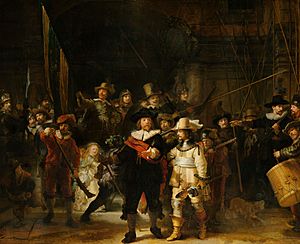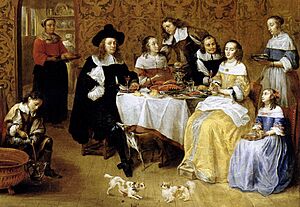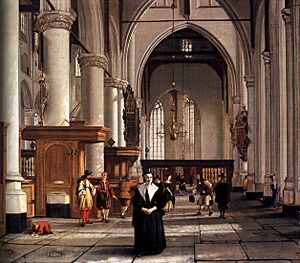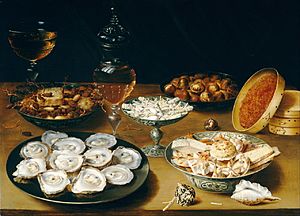Dutch Golden Age facts for kids
The Dutch Golden Age (called Gouden Eeuw in Dutch) was a special time in the history of the Netherlands. It lasted from about 1588, when the Dutch Republic was formed, until 1672. During this period, the Netherlands was very strong in trade, science, art, and colonization overseas. It was one of the most important countries in Europe.
The first part of this era was during the Eighty Years' War, which ended in 1648. The second part lasted until the Franco-Dutch War began. Dutch explorers and traders, many working for companies like the Dutch East India Company and Dutch West India Company, set up trading posts and colonies in the Americas, Southern Africa, and Asia. The strong Dutch States Navy protected these areas. The Dutch also played a big role in the global trade networks of the time.
Dutch culture also grew a lot during this period. However, by the end of the 17th century, wars with other countries and a decrease in economic power led to the end of this golden time. Historians have called the rise of the Dutch Republic to a world power the "Dutch Miracle." But the term "Dutch Golden Age" is now debated because the Netherlands was heavily involved in slavery and colonialism during this time. Some museums in the Netherlands, like the Amsterdam Museum, no longer use the term.
Contents
How the Golden Age Began
In 1568, the Seven Provinces (which later signed the Union of Utrecht) started a fight against King Philip II of Spain. This led to the Eighty Years' War. Before Spain could take back all the Low Countries, a war started between England and Spain. This stopped the Spanish army. They controlled important trading cities like Bruges and Ghent, but not Antwerp, which was a very important port.
Antwerp fell in 1585 after a long fight. This event created a clear split between the Northern and Southern Netherlands (which is mostly modern Belgium). The United Provinces (today's Netherlands) kept fighting until the Twelve Years' Truce. The war finally ended with the Peace of Westphalia in 1648. This treaty officially recognized the Dutch Republic as an independent country, free from Spain.
Skilled People Move to the Dutch Republic
Many Protestant skilled workers and rich merchants lived in the port cities of Bruges, Ghent, and Antwerp. When Antwerp surrendered in 1585, Protestants who didn't want to become Catholic had four years to leave the city and Spanish lands. Similar deals were made in other places.
More Protestants moved north between 1585 and 1630 than Catholics moved south. Many of those who moved north settled in Amsterdam. This helped Amsterdam grow from a small harbor into one of the world's most important ports and business centers by 1630.
Besides the large number of Protestants moving from the southern to the northern Netherlands, other refugees also arrived. These included Sephardi Jews from Portugal and Spain, and later Protestants from France. Even the Pilgrim Fathers stayed in the Netherlands for a while before sailing to the New World.
Hard Work and Education
The Dutch Republic's success was partly due to its strong work ethic, based on Calvinism. This encouraged people to save money and get an education. This led to very low interest rates and high literacy rates in Europe. Having a lot of money available helped the Dutch build a large fleet of ships. It also allowed them to store many goods, which helped keep prices stable and create new business chances.
Cheap Energy Sources

Other things also helped trade, industry, arts, and science grow in the Netherlands. One important factor was having cheap energy from windmills and peat (a type of fuel from decayed plants). Peat was easy to move to cities using canals. The invention of the wind-powered sawmill made it possible to build a huge fleet of ships. These ships were used for worldwide trade and to protect the Republic's business interests.
Smart Business and Money

In the 17th century, the Dutch were skilled sailors and mapmakers. They started trading with the Far East and became very powerful in world trade. Before them, the Portuguese and Spanish had this power. Even the maps used by the Spanish to attack Dutch cities were made by Dutch mapmakers!
In 1602, the Dutch East India Company (VOC) was created. It was one of the first big companies owned by many people, with shares traded on the Amsterdam Stock Exchange. The VOC had a special right from the Dutch government to trade with Asia for 200 years. It became the largest business in the 17th century. Spices were brought in large amounts and made huge profits because they were hard to get and in high demand. Even today, the Dutch word peperduur (meaning "as expensive as pepper") shows how costly spices were back then. To help with the growing trade, the Bank of Amsterdam was set up in 1609. This bank was a very early form of a central bank.
While trade with the Far East was famous, the main source of wealth for the Dutch Republic was actually trade with the Baltic countries and Poland. This was called the "Mothertrade" (Moedernegotie). The Dutch imported huge amounts of basic goods like grain and wood. They stored these in Amsterdam, so Holland always had enough supplies. They could also sell these goods for profit. This meant the Dutch Republic didn't suffer from bad harvests and hunger like other countries, such as France and England, often did in the 17th century. Instead, they profited when others struggled.
Good Location
The location of the Dutch Republic also helped it become wealthy. It was located between the Bay of Biscay and the Baltic Sea. Cities like Seville, Lisbon, and the Baltic ports were too far apart for direct trade. This allowed the Dutch to act as middlemen. They carried salt, wine, cloth, and later silver, spices, and goods from colonies to the east. They brought Baltic grains, fish, and ship-building materials to the west. The Dutch owned a huge share of European shipping, more than half during most of their powerful period.
The Dutch Empire
Outside of Europe, the Dutch Republic also did very well. The Dutch East India Company (VOC) and the Dutch West India Company (WIC) not only controlled the spice trade, but their ships also ruled the world's oceans. This made England very jealous of the Dutch Republic's economic success. Even though both countries had fought Spain during the Eighty Years War, they became enemies when the Dutch Republic built a large colonial empire. This led to the Anglo-Dutch Wars.
The wealth gained from this empire sometimes came with terrible actions against local people. For example, in 1621, Jan Pieterszoon Coen ordered the killing of almost all the people on the Banda Islands.
For a short time, the Dutch Republic was very successful in Brazil. The Dutch took control of the coast between the Amazon River and the São Francisco River from the Portuguese. Under Governor John Maurice, Prince of Nassau-Siegen (1637-1644), the profitable sugar trade was mostly controlled by the Dutch.
Curaçao was taken in 1634. By 1648, Aruba and Bonaire were also under Dutch control. A promising colony in North America was New Amsterdam (which is now New York City).
The Netherlands became a major player in the transatlantic slave trade by taking over Portuguese trading posts. In the 17th century, routes for African slaves mostly went from Elmina in Ghana to Brazil and the Caribbean Islands. Elmina was captured in 1637, and Axim in 1642. In 1641, led by Cornelis Jol, Angola was also taken. It's thought that more than 550,000 people were forced into slavery and brought to America on Dutch ships. Conditions on these voyages were terrible, and many enslaved people died before reaching their destination. This trade also caused huge problems for African societies. While estimates of profit vary, slavery was a key part of how the Americas were colonized.
Asian slaves were also traded a lot. Slaves were essential for labor in the Dutch colonial empire during the Golden Age. In the second half of the 17th century, half the people in Batavia (a Dutch city in Asia) were enslaved.
Trading with Japan
Amsterdam's strong position as a trade center grew even more in 1640. The Dutch East India Company (VOC) gained a special right to trade only with Japan. This trade happened through their trading post on Dejima, an island in the bay of Nagasaki. From here, the Dutch traded between China and Japan and paid tribute to the shōgun (Japan's military ruler). Until 1854, the Dutch were Japan's only connection to the Western world.
The scientific knowledge brought from Europe became known in Japan as Rangaku, or Dutch Learning. The Dutch helped Japan learn about the industrial and scientific changes happening in Europe. The Japanese bought and translated many science books from the Dutch. They also got Western curiosities and goods (like clocks) and saw demonstrations of new Western inventions (like electricity and hot air balloons). In the 17th and 18th centuries, the Dutch were arguably the wealthiest and most scientifically advanced European nation. This put them in a unique position to share Western knowledge with Japan.
Power in Europe
The Dutch also controlled much of the trade between European countries. The Netherlands was in a good spot, at a crossroads of east-west and north-south trade routes. It was also connected to a large German area through the Rhine river. Dutch traders shipped wine from France and Portugal to the Baltic lands. They returned with grain for countries around the Mediterranean Sea. By the 1680s, almost 1000 Dutch ships entered the Baltic Sea each year to trade. The Dutch also gained control of much of the trade with the new English colonies in North America. After the war with Spain ended in 1648, Dutch trade with Spain also grew.
Other Industries
Industries within the Netherlands also grew. Shipyards and sugar refineries are good examples. As more and more land was used, partly by turning lakes into polders (land reclaimed from water) like the Beemster, Schermer, and Purmer, local grain farming and dairy farming increased a lot.
Social Structure
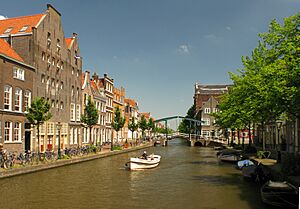
In the Netherlands during the 17th century, a person's social standing was mostly based on how much money they had. Land-owning nobles were not as important because they often lived in less developed areas. Instead, the rich city merchants were the most powerful group in Dutch society. Religious leaders also didn't have much worldly power. The Catholic Church had been mostly suppressed since the start of the Eighty Years' War with Spain. The new Protestant movement was divided, but it still had a lot of social control in many areas, sometimes even more than the Catholic Church.
However, this doesn't mean nobles had no social status. Rich merchants actually bought their way into the nobility by buying land and getting a coat of arms. Nobles also mixed with other classes for money reasons. They married their daughters to rich merchants, became traders themselves, or took on government or military jobs. Merchants also started to value government jobs as a way to gain more money and respect. Universities became a path to public office. Rich merchants and nobles sent their sons on a "Grand Tour" through Europe. These young men, often with a private tutor, visited universities in different European countries. This mixing of rich citizens and nobles was most common in the second half of the century.
After nobles and rich citizens came the well-off middle class. This group included Protestant ministers, lawyers, doctors, small merchants, factory owners, and clerks for large government groups. Below them were farmers, craftspeople, shopkeepers, and government workers. At the bottom were the "paupers": poor farmers, many of whom went to cities to try their luck as beggars or day laborers.
Workers and laborers generally earned more than in most of Europe and had a good standard of living, though they also paid higher taxes. Farmers did well by growing crops needed to feed the city and seafaring populations.
Women's Roles
In 17th-century Dutch homes, women were mainly in charge of the house and family tasks. In Dutch culture, the home was seen as a safe place away from the outside world. Also, a well-run home was thought to reflect the stability and success of the Dutch Republic itself. The home was a key part of public life. People walking by could see the decorated entrance halls, which showed a family's wealth and social standing. The home was also a place for neighbors, friends, and extended family to meet.
The physical space of the Dutch home was set up for different genders. In the front of the house, men had a small area for work or business, called the Voorhuis. Women controlled most other parts of the house, like kitchens and private family rooms. Even though husbands had power in public life and wives in domestic life, women in 17th-century Dutch society had many freedoms within their own area of control. Dutch women could take communion with men, and widows could inherit property and manage their own money and their husband's wills. However, a woman's main role was still in household duties. There is evidence that some wives had a lot of control in family businesses. Many books were written by men telling women how to do household tasks. The most popular was Jacob Cats' Houwelyck. Paintings from the 17th century show that women's most important tasks included supervising maids, cooking, cleaning, needlework, and spinning.
Unmarried Women

Art and literature from the time show that unmarried young women were valued for being modest and hardworking. This period in a woman's life was seen as the most delicate. From a young age, city girls were taught various household duties by their mothers, including reading. This prepared them for life as housewives. Dutch art from this time shows the ideal way a young unmarried girl should behave in situations like courtship. These paintings often included themes of gardens, nature, music lessons, parties, needlework, and receiving love letters. However, these ideals didn't always match reality. Travelers' stories described the freedoms young women had in courtship. Calvinist sermons about the dangers of leaving young women alone also suggested that parents often didn't watch their children closely in matters of young love.
Married Women and Mothers
Dutch writers, like Jacob Cats, shared common public opinions about marriage. He and other cultural leaders were influenced by Calvinist ideas. These ideas stressed equality between husband and wife, saw companionship as the main reason for marriage, and viewed having children as a natural result of that companionship. However, some ideas still saw women as the weaker sex. The image of a turtle was often used to show the separate roles and strengths of both genders. Besides supervising maids, cooking, cleaning, and needlework, women were also encouraged to manage some money for the household, like going to market and buying food.
Motherhood was highly valued in Dutch culture. Mothers were encouraged to breastfeed their children, as using a wet nurse was thought to prevent a bond from forming. The Dutch believed that a mother's milk came from her blood and that feeding it to the baby would bring health benefits. In 17th-century Dutch society, children were expected to first learn about religion at home. So, women, along with their husbands, used family meal times to talk about religious topics and pray.
Older Women and Widows
17th-century Dutch culture had mixed feelings about older people, especially older women. Some Dutch writers saw old age as a beautiful step from life to death. Others saw aging as a sickness where a person slowly gets worse until they die. Still others praised the elderly as wise and deserving of great respect. However, writings about how older women and widows should behave stressed that they should be religious, moderate, and live a quiet life. Unlike art in other European countries, Dutch art rarely showed older women as ugly or strange. Instead, they were often shown as religious and pure figures that younger women could look up to.
Religion
Calvinism was the official religion in the Dutch Republic, but this didn't mean everyone believed the same thing. Although the Netherlands was more tolerant than nearby countries, wealth and social status mostly belonged to Protestants. Cities with many Catholics, like Utrecht and Gouda, didn't get as many benefits from the Golden Age. Even among Protestants, beliefs were not always the same. At the beginning of the century, big arguments between strict Calvinists and more open Protestants, called Remonstrants, divided the country. The Remonstrants believed in freedom of thought, while their stricter opponents (Contra-Remonstrants) won a major victory at the Synod of Dort (1618–19). Having many different religious groups probably helped make religious intolerance difficult.
Renaissance Humanism, a way of thinking that valued human reason and knowledge, also took root. Thinkers like Desiderius Erasmus (c. 1466–1536) helped create a tolerant atmosphere.
Tolerance towards Catholics was harder to maintain, as religion had been a big part of the Eighty Years' War against Spain (along with political and economic freedom). However, intolerance could often be overcome with money. So, Catholics could pay to hold ceremonies in a hidden church (a house that secretly served as a church), but they couldn't hold public jobs. Catholics often stayed in their own parts of town, even though they were one of the largest religious groups. For example, the Catholic painter Johannes Vermeer lived in the "Papist corner" of Delft. The same was true for Anabaptists and Jews.
Overall, the country was tolerant enough to attract people seeking religious freedom from other countries. This included Jewish merchants from Portugal who brought much wealth. When the Edict of Nantes was canceled in France in 1685, many French Huguenots (Protestants) moved to the Netherlands. Many of them were shopkeepers or scientists. However, some people, like the philosopher Baruch Spinoza (1677), still faced social difficulties.
Science
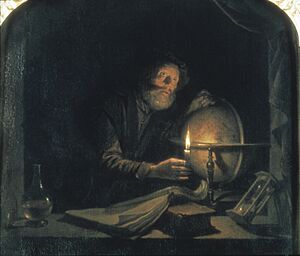
Because of its open-minded environment, the Dutch Republic attracted scientists and thinkers from all over Europe. The famous University of Leiden (started in 1575 by Willem van Oranje to thank Leiden for its strong fight against Spain) became a meeting place for smart people. Jan Amos Comenius, a Czech educator, was known for his ideas on education. He moved to the Dutch Republic to escape religious persecution and lived his last 14 years in Amsterdam, publishing many important works there. French philosopher and mathematician René Descartes (1596-1650) lived in Holland for over 20 years. He also had his most important books published in Amsterdam and Leiden. Another French philosopher, Pierre Bayle, moved to the Dutch Republic in 1681 and became a professor in Rotterdam. As historian Bertrand Russell noted, Holland was very important in the 17th century as the only country where people had freedom to think and write. Many famous thinkers, like Thomas Hobbes, John Locke, and Baruch Spinoza, found refuge there.
Dutch lawyers were known for their knowledge of international sea law and commercial law. Hugo Grotius (1583–1645) was a key figure in creating international law. He came up with the idea of "Free seas" (Mare liberum), which England, the Netherlands' main rival in world trade, strongly disagreed with. He also wrote laws about conflicts between countries in his book De lure Belli ac pacis ("On the law of war and peace").
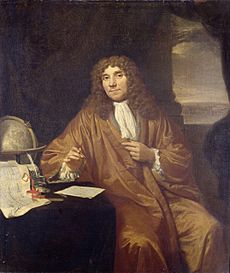
Christiaan Huygens (1629–1695) was a famous astronomer, physicist, and mathematician. He invented the pendulum clock, which was a big step towards accurate timekeeping. He also explained planetary rings around Saturn and contributed to the study of optics. The most famous Dutch scientist in optics was Antonie van Leeuwenhoek. He was the first to carefully study microscopic life and was the first person to describe bacteria. This laid the groundwork for microbiology. His "microscopes" were simple magnifiers, not compound microscopes. He was very skilled at grinding lenses, some as small as 1mm, which allowed for magnifications up to 245 times.
The famous Dutch hydraulic engineer Jan Leeghwater (1575–1650) won important battles in the Netherlands' ongoing fight against the sea. Leeghwater added a lot of land to the republic by turning several large lakes into polders, pumping the water out with windmills.
Culture
Cultural growth in the Netherlands was different from neighboring countries. With a few exceptions (like Dutch playwright Joost van den Vondel), the Baroque art style didn't have much influence. Its grand and showy style didn't fit the simpler tastes of the mostly Calvinistic population. The main force behind new cultural developments was the citizens, especially in the western provinces like Holland, and to a lesser extent Zeeland and Utrecht. In other countries, rich nobles often supported artists. But in the Netherlands, wealthy merchants and other rich citizens played this role.
Important places for cultural activities were town militias (Dutch: schutterij) and chambers of rhetoric (rederijkerskamer). Militias were for town defense and policing, but they also served as meeting places for wealthy people. These people were proud to be part of the militia and paid well to have their group portraits painted. Chambers of rhetoric were city groups that promoted writing and performing arts, like poetry, plays, and discussions, often through contests. Cities were proud of these groups and supported them.
In the Dutch Golden Age, middle-class meals had many different dishes. By the 15th century, fancy cooking started to appear, mostly for nobles. But from the 17th century, wealthy citizens could also enjoy these kinds of dishes. The Dutch Empire allowed spices, sugar, and exotic fruits to be brought into the country. By the late 17th century, drinking tea and coffee became more common. Tea was served with sweets, candy, or marzipan and cookies. A rich Dutch meal at that time included many fancy dishes and drinks.
The elite wore black clothes as a sign of their high status. This was because black dye was difficult and expensive to make, and the clothes often had costly decorations. This is different from the common idea that it was only for religious reasons.
Painting
Dutch Golden Age painting followed many trends seen in Baroque art elsewhere in Europe, like Caravaggism (using strong light and shadow) and naturalism (showing things as they really are). But Dutch painters were leaders in developing still lifes, landscapes, and genre painting (scenes of everyday life). Portraits were also popular. However, history painting – which was usually the most important type of painting – was hard to sell. Church art was almost non-existent, and not many sculptures were made. While art collecting was common elsewhere, art historians point to the growing number of wealthy Dutch middle-class and successful merchant art buyers as key reasons for the popularity of certain painting subjects.
This trend, along with the lack of church support (unlike in Catholic Europe), led to many "scenes of everyday life" and other non-religious subjects. Landscapes and seascapes, for example, show the land reclaimed from the sea and the sources of trade and naval power that marked the Republic's Golden Age. A special type of still life was the pronkstilleven (Dutch for 'showy still life'). This ornate style of still-life painting developed in the 1640s in Antwerp by Flemish artists. They painted still lifes that showed a lot of wealth by including many different objects, fruits, flowers, and dead animals, often with living people and animals. This style was quickly adopted by artists from the Dutch Republic.
Today, the most famous painters of the Dutch Golden Age are Rembrandt, the Delft master of genre Johannes Vermeer, the innovative landscape painter Jacob van Ruisdael, and Frans Hals, who brought new life to portrait painting. Some notable art styles and trends include Haarlem Mannerism, Utrecht Caravaggism, the School of Delft, the Leiden fijnschilders (fine painters), and Dutch classicism.
Architecture
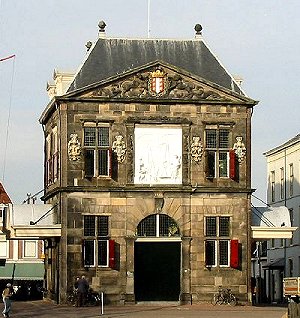
Dutch architecture reached new heights in the Golden Age. Cities grew a lot as the economy boomed. New town halls, weighhouses, and warehouses were built. Merchants who became rich ordered new houses along the many new canals dug in and around cities (for defense and transport). These houses had decorated fronts that showed off their new status. In the countryside, many new castles and grand homes were built, but most of them no longer exist.
Early in the 17th century, old Gothic styles were still common, mixed with Renaissance ideas. After a few decades, French classicism became popular. This style emphasized vertical lines, used less decoration, and preferred natural stone over bricks. In the last decades of the century, this trend towards simplicity became even stronger. From around 1670, the most important part of a house front was its entrance, with pillars on each side and sometimes a balcony above it, but no other decorations.
Starting in 1595, new Protestant churches were built, many of which are still famous landmarks today.
The most famous Dutch architects of the 17th century were Jacob van Campen, Pieter Post, Philips Vingboons, Lieven de Key, and Hendrick de Keyser.
Sculpture
Dutch achievements in sculpture in the 17th century are not as well-known as their paintings and architecture. Fewer sculptures were created than in neighboring countries. This was partly because Protestant churches did not have many statues inside, as people objected to the Roman Catholic worship of statues during the Reformation. Another reason was that there were fewer nobles in the Netherlands who would commission sculptures. Sculptures were made for government buildings, private homes (often decorating house fronts), and the outside of churches. There was also a demand for grave monuments and portrait busts.
Hendrick de Keyser, who was active at the start of the Golden Age, is one of the few important Dutch sculptors. In the 1650s and 1660s, the Flemish sculptor Artus I Quellinus, along with his family and followers like Rombout Verhulst, created the classicizing decorations for the Amsterdam city hall (now the Royal Palace, Amsterdam). This building remains the most important example of Dutch Golden Age sculpture.
Literature
The Golden Age was also an important time for literature. Some of the major writers of this period were Gerbrand Bredero, Jacob Cats, Pieter Hooft, and Joost van den Vondel.
During this time, a tolerant environment developed compared to other European countries with strict censorship. This helped the Dutch become a powerhouse in the book trade. Historians call this change the 'Dutch miracle.' Also, the Dutch had high literacy rates, and Dutch business owners took advantage of this. As a result, 17th-century Holland became a major center for producing news, Bibles, and political pamphlets. Louis Elzevir and his family created one of the most famous book publishing businesses. The House of Elzevir produced small, affordable, and reliable editions of classical Latin texts. The Elzevir family business ended in 1712, and the 'Dutch miracle' in book trade faded as other countries caught up.
|


